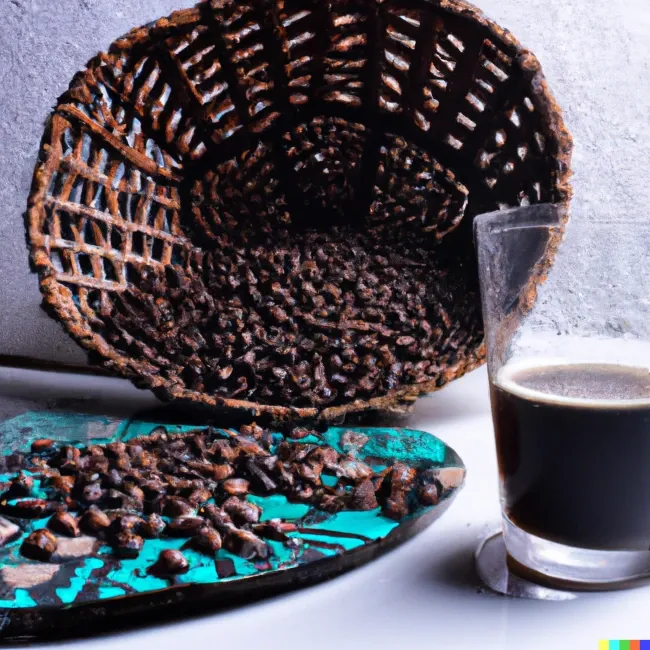| Robusta Coffee |
If you’re a coffee enthusiast on the
lookout for a brew that packs a punch, look no further than Robusta coffee. Robusta
coffee, scientifically labeled Coffea canephora, emerges as a powerhouse among
coffee bean species, standing alongside the more delicate Arabica variety.
Hailing from Central and West Africa, Robusta beans boast a distinctive flavor
profile, marked by a robust, bitter taste with subtle woody undertones.
Robusta vs. Arabica: A Caffeine Showdown
Robusta coffee takes the lead with its
higher caffeine content compared to its counterpart, Arabica. This elevated
caffeine concentration imparts Robusta with unparalleled strength and vigor,
making it the go-to choice for those seeking a morning pick-me-up or an extra
boost to power through a demanding day.
Resilience Personified: Robusta’s Triumph
Over Adversity
In the battle of resilience, Robusta
emerges victorious. Unlike the finicky Arabica plants, Robusta’s hardiness
allows it to thrive in a broader spectrum of climates and altitudes. This
tenacity positions Robusta beans as vital players in the global coffee
industry, flourishing where Arabica might falter.
Espresso Euphoria: Robusta’s Role in
Espresso Brewing
For lovers of espresso, Robusta is
indispensable. Its rich, full-bodied character perfectly complements the
intense flavors and concentrated brewing process of espresso. When blended with
Arabica beans, Robusta contributes a satisfying crema and a bold kick, creating
an espresso experience that’s nothing short of extraordinary.
Economic Empowerment and Sustainable
Cultivation
Beyond its sensory allure, Robusta coffee
plays a pivotal role in the economic landscape of coffee-producing regions. Its
hardiness and high yield make it a valuable crop for farmers, significantly
boosting local economies. Moreover, its adaptability promotes sustainable
farming practices, reducing the need for extensive cultivation and minimizing
environmental impact.
The Art of Cultivating Excellence
Unlocking the true potential of Robusta
coffee demands precision in cultivation and processing. Beans are meticulously
harvested at full maturity and undergo a careful processing and roasting ritual
to bring forth their distinctive flavor profile. Handled with expertise,
Robusta coffee is a testament to the harmonious blend of craftsmanship and
nature’s bounty.
The Future Unveiled: Robusta’s Ascendance
in the Coffee World
As the coffee industry evolves, Robusta
beans gain renewed recognition and respect. Their bold flavor and adaptability
position them as essential components in diverse coffee blends, catering to a
wide array of palates. With the escalating demand for specialty coffees and
unique flavor profiles, Robusta’s influence in the coffee world is poised for
expansion.

Tradional Robusta Coffee

Exploring Robusta Varietals: A Journey of
Distinct Flavors
Within the realm of Robusta coffee, a
captivating array of varietals awaits exploration, each bearing its own unique
characteristics. Varieties like Conilon from Brazil and Parchment Robusta from
India showcase the potential for nuanced flavors within the broader Robusta
category. These varietals are gaining traction among coffee enthusiasts,
offering depth and complexity in every cup.
Beyond the Brew: Robusta’s Impact on
Communities
The cultivation of Robusta coffee
reverberates through the communities that nurture its growth. From providing
stable livelihoods for farmers to bolstering local economies, Robusta plays a
pivotal role in the social fabric of coffee-producing regions. Through
sustainable farming practices and fair trade initiatives, the impact of Robusta
coffee transcends flavor, creating positive change in the lives of those
involved.
A Symphony of Flavors: Pairing Robusta with
Culinary Delights
Robusta coffee’s bold flavor profile opens
a realm of pairing possibilities. Its strong, earthy notes complement an array
of flavors, making it an excellent choice for pairing with foods from dark
chocolate to hearty stews. Whether enjoyed with a decadent dessert or as an
accompaniment to a savory dish, Robusta’s robustness holds its own in the world
of culinary companions.
Embracing the Robusta Experience: A Journey
of Richness
For those in pursuit of a coffee experience
that awakens the senses and invigorates the spirit, Robusta coffee stands as a
steadfast companion. Its boldness and strength extend an invitation to savor
the richness of life, one cup at a time. Whether relished as a straight shot of
espresso or as the cornerstone of a signature blend, Robusta coffee embodies
the essence of a truly robust coffee experience.
In the vast expanse of the coffee world,
Robusta’s presence speaks volumes about the diversity and depth of flavors
awaiting exploration. As we raise our cups to this bold and strong brew, let’s
celebrate the journey that brings this exceptional coffee to our tables, and
toast to the vibrant future that awaits within each robust sip.
To find out the difference between Arabica
and Robusta coffee, please read our previous article entitled Arabica Vs. Robusta: Decoding The
Distinctive Personalities Of Coffee’s Finest.
Some Robusta Coffee References
The following are several sources that you
can use as references regarding Robusta coffee articles and what I have said
above:
- Davis, D. R. (2010). Coffee for
Wellness: From Antioxidants to Your Brain. In Coffee: Emerging Health Effects
and Disease Prevention (pp. 1-16). John Wiley & Sons. - Carvalho, V. D., Magalhães, L. M., &
Mendonça, F. (2014). A review on the coffee agro-industry in Brazil. Ciência e
Agrotecnologia, 38(2), 103-113. - Lacher, R. G. (1986). Robusta coffee: a
review of its physiological ecology. Advances in Agronomy, 40, 37-78. - Mendesil, E., & Woldetsadik, K.
(2019). A review on coffee processing. International Journal of Food Science,
2019. - Sudaryanto, T., Nugroho, R. A., &
Haryanto, B. (2014). The effects of altitude on robusta coffee bean
characteristics: A case study on coffee farms in Central Java, Indonesia. Food
Research, 3(3), 235-242. - Rao, P. S., & Kapoor, A. C. (2008).
Traditional and new methods for decaffeination of coffee. Journal of Food
Science and Technology, 45(5), 361-371. - Toci, A. T., Farah, A., & Pezza, L.
(2014). Rapid quantification of 16-O-methylcafestol in coffee oil by 1H NMR
spectroscopy. Food Chemistry, 145, 453-458. - Santos, A. D. O., Sousa, G. P., Ramos,
R. F., Ferreira, M. D. S., & Borges, A. D. M. (2016). Phenological growth
stages of robusta coffee. Coffee Science, 11(2), 156-163.
Please make sure to verify the availability
and credibility of these sources before using them for any formal or academic
purposes.
Enjoy reading while sipping your coffee!










